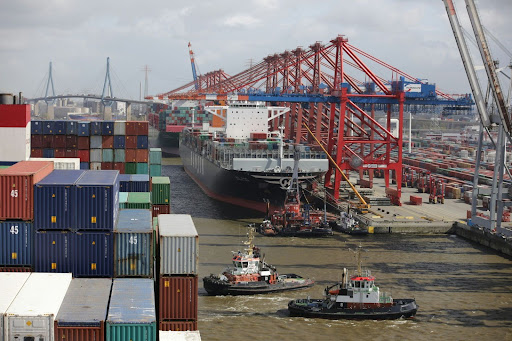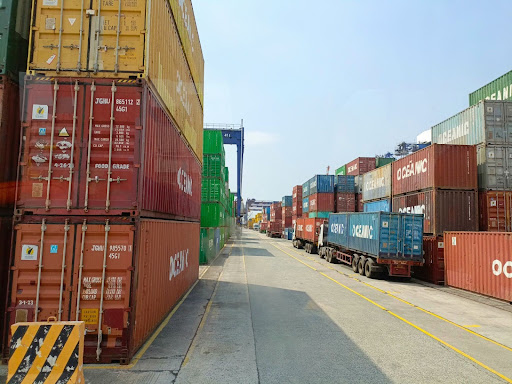Wondering how technology is reshaping supply chains? In this article, we provide key business and logistics insights: how technology is reshaping supply chains with AI, IoT, and blockchain, which are revolutionizing supply chain management. From real-time tracking to enhanced resilience, discover the practical impacts and future trends.
Technological Advancements in Supply Chain Management
The logistics industry is witnessing a paradigm shift, driven by the integration of advanced technologies like AI, IoT, and blockchain. These innovations are not merely tools but are transforming the very fabric of supply chain management:
- Real-time tracking, enabled by these technologies, significantly improves supply chain visibility.
- This visibility allows for quicker responses to disruptions.
- It also enables better inventory optimization.
- The collective and data-driven approach facilitated by these tools is essential for effective decision-making and data management in supply chains.
Collaboration between solution providers and technology developers is crucial in creating effective tools that enhance supply chain operations. For instance, AI’s ability to analyse vast amounts of data and predict trends is revolutionizing supply chain planning and execution.
Similarly, IoT’s real-time data capabilities and blockchain’s secure data sharing are providing unprecedented transparency and efficiency. Companies are also turning to reliable inbound logistics solutions to strengthen cross-border supply chain networks, ensuring speed and efficiency in global trade.
These technological advancements are not just reshaping supply chains; they are setting new benchmarks for supply chain efficiency and resilience.
The Role of Artificial Intelligence in Supply Chains
Artificial intelligence (AI) is making waves in supply chain management by transforming how data is analyzed, trends are forecasted, and tasks are automated. AI’s impact on supply chains is profound, leveraging machine learning and ai and machine learning to analyze historical and real-time data, thus enhancing the accuracy of demand forecasts and optimizing inventory levels.
Generative AI (GenAI), a subset of AI, is particularly noteworthy for its ability to learn and refine analysis over time, offering supply chain professionals powerful tools to modernize their systems and automate processes. Partnering with IT staffing experts like TechCloud enables companies to recruit the right tech talent needed to deploy these advanced solutions effectively.
Internet of Things (IoT) in Logistics Operations
The Internet of Things (IoT) is revolutionizing logistics operations by providing connectivity and real-time data through sensors and RFID tags. IoT technology enables real-time monitoring of inventory, shipments, and equipment, offering visibility and precision at a piece-level.
Systems like Ultra Track exemplify how IoT is utilized for enhanced tracking, making logistics networks more efficient and responsive. To support this growing demand for data-driven IoT applications, businesses often rely on high-performance storage from an industrial m2 sata provider to ensure reliability and efficiency across devices and connected systems.
Blockchain for Supply Chain Transparency
Blockchain technology is a transformative tool within supply chains, significantly enhancing transparency and trust. Ensuring secure data sharing among supply chain partners, blockchain minimizes misinformation risk and fosters greater visibility and accountability.
This technology not only streamlines operations but also reinforces the integrity of supply chain operations, building trust among various stakeholders.
Sustainable Supply Chain Strategies
Sustainability is no longer an option but a necessity for competitive advantage and regulatory compliance in supply chains. It has become a core component of logistics strategy, impacting all areas of the supply chain. Digital platforms play a crucial role in sustainability reporting by providing centralized systems for emissions data input, making it easier for companies to monitor and manage their environmental impact.
Companies should prioritize initiatives like reducing emissions and engaging in responsible sourcing to achieve sustainability. Educating suppliers on emissions data capture is vital for reaching sustainability targets. Developing a transition plan for delivery fleets to electric vehicles is an effective strategy for reducing carbon emissions.
Analysing the entire supply chain process can help identify areas to reduce vehicle tailpipe emissions. It’s crucial to establish a solid emissions baseline. This helps in monitoring progress and setting reduction targets. By 2025, sustainability and adaptability to rapid technological changes will be crucial for supply chain management.
Reducing Carbon Emissions with Electric Vehicles
Transitioning to electric vehicles is becoming a priority for many companies as it significantly cuts down on logistics carbon emissions. This move not only aligns with sustainability goals but also offers enhanced efficiency and potential cost savings in the long run.
Lifecycle Management for Sustainable Sourcing
Lifecycle management tools facilitate the responsible sourcing of materials by enabling companies to track the sustainability of their supply chain. These tools help ensure that sourcing practices are environmentally friendly and socially responsible, contributing to a resilient supply chain.
ESG Integration in Supply Chain Planning
Incorporating ESG (Environmental, Social, and Governance) criteria in supply chain strategies is essential for improving stakeholder relationships and enhancing overall sustainability performance.
A data management strategy should prioritize alignment with business objectives to maximize value creation.
Optimizing Inventory Management with Advanced Technologies
Modern technologies are revolutionizing inventory management by automating processes, providing real-time insights, and optimizing stock levels to minimize waste. Advanced technologies facilitate the automation of inventory tasks, improving efficiency and accuracy in inventory management. By maintaining precise stock levels, businesses can reduce excess stock and waste, enhancing overall supply chain efficiency.
Additive manufacturing, for instance, allows for on-demand production, reducing waste and transportation costs associated with traditional supply chains. This technology enables production closer to demand locations, transforming the traditional supply chain by allowing on-demand manufacturing.
Real-Time Inventory Tracking with IoT
IoT sensors provide real-time visibility of inventory, helping businesses avoid stockouts and maintain optimal stock levels. IoT provides continuous updates on stock levels, enhancing inventory accuracy and enabling seamless device integration for improved real-time tracking and management.
Automated Replenishment Systems
Automated replenishment systems facilitate timely restocking, significantly decreasing the need for manual intervention. These systems trigger stock orders based on real-time inventory data, streamlining the restocking process and ensuring optimal stock levels are maintained through automation.
Navigating the Global Trade Landscape with Technology
As global trade becomes more complex, technology plays a crucial role in streamlining global logistics operations and maintaining a competitive edge. Advances in logistics efficiency are driven by autonomous vehicles and drones, which are expected to significantly lower delivery costs and improve overall logistics operations.
The integration of these emerging technologies in a business context is reshaping the global trade landscape, allowing businesses to overcome challenges and align with customer experience and customer demands through technological innovation.
Compliance and Regulatory Demands
Compliance with international trade regulations is crucial to avoid severe penalties, including fines up to $1 million per violation. Key components of trade compliance involve strict import and export controls, ensuring adherence to both safety and legal standards.
Integrating various regulatory requirements into a single platform, technological solutions significantly ease compliance management for businesses. Automation and digital solutions streamline compliance processes, allowing for more efficient management of complex regulations, and digital tools help businesses adapt more effectively to constantly changing regulatory environments.
Leveraging Data Analytics for Global Trade Insights
Data analytics can uncover trends in import and export activities, enabling businesses to make informed decisions about market opportunities. Advanced data analytics allow businesses to identify trends in trade patterns, facilitating proactive responses to market changes.
Analyzing shifting global trade patterns allows businesses to anticipate market demands and adjust strategies accordingly. Real-time data analysis allows businesses to react promptly to shifts in global trade trends and market dynamics, ensuring they remain competitive in an ever-changing market.
Enhancing Border Management with Technology
Technological solutions can streamline customs processes, leading to improved efficiency and reduced delays at borders. Automating customs clearance processes and improving communication between agencies, technology significantly reduces border delays.
Smart border technologies utilize big data and biometric systems to improve the efficiency and security of border controls, ensuring smoother and faster global shipments.
Future Trends in Supply Chain Technology
Technology is driving the future of supply chains in 2025, focusing on sustainability and resilience. Technology-driven solutions offer benefits such as overcoming challenges, streamlining operations, and aligning with customer demands. Emerging trends reshaping supply chains include the adoption of new technologies, sustainability goals, and the influence of shifting global dynamics.
Supply chain leaders face new challenges, including ESG considerations, the integration of robotics, and the implications of the metaverse.
Autonomous Vehicles and Drones in Logistics
Autonomous vehicles can significantly reduce operational costs by eliminating the need for human drivers and optimizing fuel use. Drones excel at last-mile delivery, ensuring faster shipment of smaller packages, especially in hard-to-reach areas.
These technologies are reshaping supply chains by enhancing logistics efficiency and reducing delivery times in global supply chains.
Additive Manufacturing and Distributed Production
Additive manufacturing, often known as 3D printing, is revolutionizing the way products are made by enabling more flexible and rapid production methods. This technology allows for localized production, significantly reducing logistics costs and delivery times by manufacturing products closer to the point of use.
On-demand production facilitated by additive manufacturing helps minimize inventory levels, reducing waste and aligning closely with real-time consumer demand. These shifts in production capabilities lead businesses to rethink traditional supply chain models, focusing on agility and customization to meet market needs effectively.
Summary
As we have explored, technology is not just an enabler but a game-changer in the realm of supply chain management. AI, IoT, and blockchain are at the forefront of this transformation, driving significant improvements in supply chain visibility, efficiency, and resilience. These technologies allow supply chain leaders to predict market demands with greater accuracy, optimize inventory management, and foster a more sustainable and transparent supply chain environment.
Looking ahead, the adoption of emerging technologies such as autonomous vehicles, additive manufacturing, and Industry 5.0 will continue to reshape supply chains, making them more agile, efficient, and human-centric. As businesses navigate this new landscape, the focus on sustainability and adaptability will be crucial. By leveraging these technological advancements, companies can not only streamline operations but also create a competitive edge in the global market. The future of supply chains is bright, filled with opportunities for innovation and growth.


